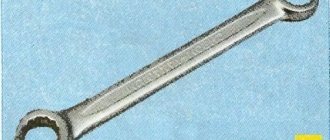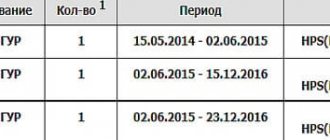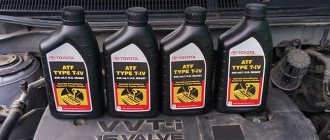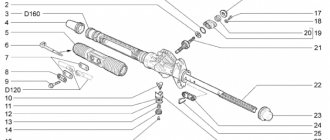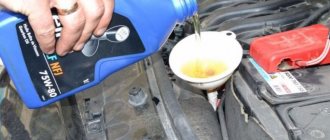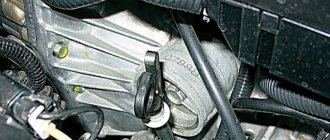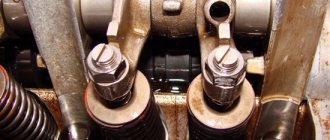Thanks to the close cooperation of the AvtoVAZ concern and Renault, car enthusiasts received a reliable and unpretentious Lada Largus car. This model has become quite popular for many reasons, including functionality, practicality, good build quality and affordable price. Due to the high ground clearance and low overhangs, excellent cross-country ability is ensured, the powerful power plant produces good dynamic characteristics, and the modern steering mechanism, complemented by hydraulic power steering, helps to steer the car with ease.
How much to fill
Unlike other LADA models, the refueling volumes of Lada Largus are not presented in the operating manual. Data for the Lada.Online website was provided by one of the LADA dealerships.
| Unit | Volume, l |
| Engine lubrication system -11189 -21129 (cast oil sump) -K7M -K4M | |
| Power steering system (power steering) | 1,2 |
| Hydraulic brake system | 0,7 |
| Air conditioning system with R-134a refrigerant | 0,475 |
Why you can’t save money when choosing power steering fluid
When choosing power steering fluid, you should pay attention to well-known manufacturers of car accessories. It is better to purchase such consumables in specialized stores for car enthusiasts, since they directly affect traffic safety
Low-quality power steering fluid may have the following disadvantages: Loss of properties at elevated temperatures. During operation, the power steering fluid on some cars “heats up” above 100 degrees Celsius. Oil with poor quality additives may begin to coagulate at such high temperatures that it will cause difficulty turning the steering wheel. Particularly low-quality power steering fluids can completely damage the power steering at high temperatures. In such a situation, the steering will continue to work, but after that the driver will have to repair the power steering elements;
Release of hazardous fumes for vehicle occupants. The amount of chemical reagents mixed into power steering fluid is no less than in car additives. At elevated temperatures, power steering fluid emits vapors that can be hazardous to the health of passengers. If you purchase such oils in specialized stores and from trusted brands, you don’t need to worry about harmful vapors, while in an effort to save money when purchasing secondhand, you can end up with a liquid containing harmful or even dangerous elements.
What technical fluids are filled from the factory?
The information below was provided by the official LADA website.
Engine oil to the engine
:
Transmission oil in the gearbox (gearbox)
:
Coolant (antifreeze)
:
Attention!
This information is for reference only and may be changed by AVTOVAZ without prior notice to the Buyer. For information on recommended working and lubricating fluids, we recommend contacting an official LADA dealer.
Still have questions? Ask in the comments!
Other background information on Lada Largus is provided here.
Share on social networks:
Found an error? Select it and press Ctrl+Enter..
All steps for changing oil on Largus “step by step”
Let's consider what to do before changing the oil in the Lada Largus engine if the number of valves is 16:
- Warm up the engine, turn off the ignition, drive the car into the pit;
- Remove the crankcase protection. You need a 10mm socket wrench - use it to unscrew the six screws from the bottom;
- Immediately unscrew the filler cap (yellow plastic).
The protection is removed for one purpose - to get to the filter.
Draining waste (old engine oil)
There is no crankcase protection now. All that remains is to take the 8-sided socket and unscrew the drain plug.
Make 1-2 turns with the key, then place an empty container and unscrew the cap by hand.
The draining time for used oil is at least 10 minutes. Be careful, the oil is hot!
After the waste has drained, the surface of the crankcase is wiped and the plug is wrapped. Thread tightening torque: 22 N*m.
Comments
TOP materials of the week
TOP products in the store (more)
Who services your Lada Largus?
Lada.Online
Lada (“Lada”) is a brand of cars produced by JSC AVTOVAZ. Previously, it was used only for export cars, and for the domestic market, cars were produced under the Zhiguli brand. In 2004, the management of AVTOVAZ announced the transition to the Latin alphabet for the official spelling of the names of all cars produced by the plant: Lada - instead of "VAZ" and "Lada".
Lada.Online is the largest Russian-language automotive resource with a daily audience of thousands, which is dedicated primarily to cars of this brand, the domestic automotive industry and the automotive world in general.
This site is not the official LADA website.
© 2022 Lada.Online. Copying of material is permitted only with a link to the source.
Source
Level check
You should start by checking the brake fluid level in the expansion tank of the ABS system. To do this, you need to look under the hood of the car, find the tank located on the rear wall of the engine compartment, and check the fluid level in the vacuum tank, which should be approximately in the middle of the MIN and MAX marks located on the side of the tank. If the level is below the minimum, then the fluid is leaking somewhere and you should go to a service station to determine the cause.
You should pay attention to the color of the liquid, which can vary from light yellow to dark brown. Since brake fluid darkens during vehicle operation due to impurities appearing in it, a dark brown fluid indicates that it needs to be completely replaced in the near future.
There should also be no burning smell or other foreign odors.
Lada Largus oil for power steering
Lada Largus is a Russian budget station wagon, which is a copy of the French model Dacia Logan MCV from 2006. The car entered production in 2012. The model is based on the B0 modular platform, common with some entry-level Renault models - Logan, Arcana, Sandero and Duster. Initially, station wagon production in Togliatti was localized by 50%, and today it can exceed 72%.
Various commercial modifications are produced at the Largus base, including a van and a refrigerated truck. The 2022 facelift version receives a new radiator grille with an updated three-dimensional rook. In 2021, the next restyled version of Largus with the design of Lada Vesta is expected to enter the market.
How much oil is in power steering Lada Largus
First generation R90, since 2012
Largus is developed on the B0 platform, common with models of the Renault Logan family. The car is no different from its sister model – the first generation Logan MCV. At the same time, unlike the French car, the Russian station wagon has a variety of modifications - not only a minivan or van, but also a refrigerated truck for various needs. In its class, Largus has practically no competitors, and therefore is in consistently high demand, despite its outdated design.
The car is equipped with 1.6 petrol engines (87-106 hp), which work with manual transmission 5. The restyled Largus 2022 model year received new bumpers and hood, original front fenders, headlights and radiator grille. The exterior mirrors and rims have also changed. Inside, the dashboard and front seats have been redesigned and have received more developed lateral support.
Power steering oil: volume – 1 liter
The influence of viscosity index on oil selection
When choosing lubricating fluids, viscosity is one of the important indicators that you need to pay attention to. The lower the outside temperature, the lower the viscosity oil should be poured into the engine.
This applies not only to Renault Duster, but also to any other car.
All-season oils work only up to certain temperatures, then you need to switch to certain brands that will perform their functions well either in severe frost or in hot weather.
After all, it is known from physics that cold reduces the fluidity of liquids, and heat, on the contrary, increases it.
The manufacturer recommends filling Renault Duster in winter, at temperatures below 20C, with oils with a viscosity of 5w40. In severe frost, such fluids retain the required fluidity and, accordingly, their lubricating properties, thereby ensuring a reliable engine start in winter.
The recommended oil viscosity for a vehicle with a diesel engine is shown below.
In summer, on the contrary, such liquids are not suitable for car operation. In the heat they will become very liquid and lose their lubricating properties.
Therefore, at temperatures of 25 degrees and above, the manufacturer recommends filling Renault Duster with oils with a viscosity of 15w40 and 20w40. When heated, they lose viscosity and become fluid.
The pour points of some brands of motor oils used in Renault Duster are shown below.
All these parameters can be seen on the packaging and you can make the right purchasing decision.
To do this, you need to know the SAE classification of motor oils.
What oil to fill in power steering Lada Largus
Original
For power steering of the Lada Largus, we recommend Elf Elfmatic G3 hydraulic oil, which is produced by the French company Total. The liquid has a mineral base, diluted with complex beneficial additives that are resistant to high and low temperatures, oxidation and corrosion. This oil is characterized by a low pour point, which ensures its universal use and adaptation to a wide temperature range.
Unoriginal
Analogues of Elf Elfmatic G3 oil are transmission oils with Dexron III approval, the features of which are a synthetic base and an increased viscosity index of 110 units. (compared to Dexron II mineral oil). The fluid has a package of stable additives, which ensures a high quality product with properties close to the original oil. Below are the optimal alternative oils with Dexron III approval for Lada Largus power steering.
Replacement, all phases
There are two different standards, DEXRON II and DEXRON III. And it seems that what kind of oil to fill in the Renault Logan power steering is clearly indicated in the documentation.
Renault fuel selection table
But if you don’t consider yourself smarter than the engineers at Avtoframos and VAZ, then you should pour DEXRON III. In addition, for these oils there is a test result from the magazine “Behind the Wheel”.
Top Ten
Unfortunately, the tests were carried out several years ago. Therefore, some modern materials are not on the list - Motul Multi HF or Motul Multi ATF, for example.
Good oil of DEXRON III standard for power steering
The list below contains time-tested options, and they are listed in order “starting from best”:
- ENEOS ATF III – “Number 1 Oil in Japan”, frost resistance – up to -46 C.
- ZIC Dexron III – semi-synthetic, low viscosity. Freezes at -40 C.
- Bizol ATF III – excellent frost resistance (-47 C), almost no foaming, but the color does not meet the standards (yellow).
- Mobil ATF D/M – good frost resistance and full compliance with its standard.
- BP Autran DX III - not the best lubricating properties.
- Luxoil ATF Dexron III – the best frost resistance (-48 C), there are no other obvious advantages.
- XADO ATF III – does not foam, lubricates well, but does not meet the requirements for corrosion resistance.
- Castrol Automatic TQ Dexron III is another “puncture with corrosion”.
- Mannol Dexron III Automatic Plus - synthetic (not suitable). No corrosion resistance.
- Elf Elfmatic G3 - in “Behind the Wheel” they placed this material in tenth place for one reason: oil actively dissolves copper.
There is no copper in the power steering system, and the last option will be one of the most suitable! Make a choice.
Reviews
Grigory, Dnepropetrovsk. I drove 110 thousand km on Largus, the car is still holding up. A decent workhorse that is worth the money. This van has paid for itself a long time ago and brings in a stable profit. I give a thumbs up to comfort and multimedia options, as long as the suspension can withstand the loads being transported from point A to point B. The VAZ 1.6 engine consumes around 11 liters in the urban cycle.
Vladimir, Lipetsk region. My wife has a Logan, and I have a more practical seven-seater Largus, suitable for forays into nature over rough terrain. The main advantage of Largus compared to the previous Logan is a lot of space. And in this regard, the station wagon simply cannot have competitors for that kind of money. The unpretentious 1.6-liter engine never fails, the main thing is to fill the oil and filters on time. Average consumption 9 l.
Source
What color should the power steering fluid be?
Another important parameter of the steering fluid is its color. On sale you can find the liquid in 3 colors: green, yellow and red
It is important to note here that power steering fluids of the same color can be mixed with each other. There is an important rule: never mix mineral and synthetic oils, this also applies to power steering fluids
We suggest you familiarize yourself in more detail with the differences between steering fluids of different colors:
Red. This color indicates that this fluid (in most cases) is used for automatic transmissions
It can be either mineral or synthetic, and when purchasing red oil, it is important to check this parameter. You can mix red power steering fluid with yellow, but not with green. Yellow
This is a universal power steering fluid that can be found in automatic and manual transmissions. As noted above, yellow oil allows for miscibility with the red variation. Green. Green power steering fluid can only be poured into cars with a manual transmission. It cannot be mixed with oils of other colors.
The parameters of viscosity, the presence of additives and other properties differ minimally between power steering fluids of the same color. That is why, when buying oil to add to the power steering reservoir, first of all, you need to look at its color, and not at other indicators.
Features of replacing power steering fluid on Largus
Thanks to the close cooperation of the AvtoVAZ concern and Renault, car enthusiasts received a reliable and unpretentious Lada Largus car. This model has become quite popular for many reasons, including functionality, practicality, good build quality and affordable price. Due to the high ground clearance and low overhangs, excellent cross-country ability is ensured, the powerful power plant produces good dynamic characteristics, and the modern steering mechanism, complemented by hydraulic power steering, helps to steer the car with ease.
What brake fluid should be used on Lada Largus
If you look at the documents from the manufacturer, you can find information that according to the maintenance regulations established for the Lada Largus car, a complete replacement of the brake fluid is carried out every 45 thousand kilometers, or at the sixth technical service at a service center station.
Comparing brake fluids with each other, you can see that the most important parameter is the viscosity of the brake fluid and its boiling point.
When operating a car in conditions of low temperatures, liquids with a high viscosity coefficient begin to behave in such a way that it becomes impossible to press the brake pedal, and, as a result, a complete failure of the braking system occurs, and it will be impossible to stop the car at all, which will entail irreparable consequences, including serious accidents.
When choosing brake fluid for a Lada Largus car, you should use the manufacturer's recommendations. The operating instructions indicate that this car model uses DOT 4 fluid (glycogel-based brake fluid), therefore, the following brands of brake fluid are suitable:
| Name | Cost, in rubles |
| LADA SUPER DOT4 | 150 |
| Mobil Brake Fluid DOT 4 | 260 |
| ROSDOT 4 | 126 |
| DOT 4 Hi Gear | 230 |
| Castrol Brake Fluid 4 | 250 |
To know how much liquid should be poured into the tank, you can again refer to the service book. The volume of brake fluid poured into Largus is 500 ml, which should be taken into account when replacing.
In this case, all brake fluids are low-viscosity and are within the same price category, so you can choose any one, but, according to reviews from car owners, one of the most optimal brake fluids is ROSDOT 4 brand fluid in terms of price and quality.
DOT class 4 fluids from different manufacturers can be mixed with each other, but if it is not known what kind of brake fluid is currently in the system, then it is worth replacing it completely, and in the future using the exact brand of fluid that is currently in use to top up the brake system circulates inside the car.
Characteristics of power steering of Lada Largus
This unit is no less important than the brake system. The safety of the driver and passengers also depends on its performance. Power steering (hydraulic power steering) provides the ability to control the car by easily positioning the drive wheels in the desired direction.
The Lada Largus is equipped with a combined type hydraulic booster, i.e. some of its elements are located directly in the steering mechanism housing. In other words, they are a component of the mechanical part of the steering column. Power steering Lada Largus consists of a standard set of elements:
There are not many components, which explains the high reliability of the hydraulic booster. Malfunctions associated with its operation occur infrequently. Typically, problems arise due to violations of operating rules by the car owners themselves. Much less often - due to the natural wear and tear of parts, but, of course, one cannot ignore the low quality of components.
Maintenance comes down to following simple rules. The main thing is to regularly check the level of working fluid in the expansion tank of the system. The power steering does not require additional adjustments.
It's easy to check; just open the hood. The fluid in the system is also needed to lubricate the power steering elements. If the level is low, parts will begin to wear out too quickly. With such use, the unit is more likely to fail.
Draining and replacing antifreeze on Largus
There are two types of internal combustion engines installed on the Lada: 8 valves and 16 valves. They have no fundamental difference in the cooling system, and therefore replacing the coolant is carried out in the same way on any of them. All work is carried out only on a cooled engine.
The procedure for draining waste fluid is simple and looks like this:
- unscrew the cap of the expansion tank Lada Largus;
- remove the metal crankcase protection (if any);
- Structurally, the manufacturer did not provide drain plugs on the cylinder block and on the radiator, so the liquid will have to be drained by loosening the lower clamps and squeezing them with pliers;
- under the radiator you should place a container capable of holding at least six liters;
- at the initial stage, it is better to tighten the cap of the expansion tank - this way antifreeze will not flow out after the lower radiator hose is disconnected, then you can gradually open the cap;
- after the liquid stops draining into the container, the pipe is put into place and secured with a clamp.
If possible, avoid contact of fluid with engine components. And also with mucous membranes and skin, because due to the chemical composition, antifreeze can cause chemical burns. And if you don’t let it cool down, then it’s thermal.
Flushing the cooling system
Sometimes it may be necessary to flush the SOD, especially when the refrigerant contains impurities, dirt, etc. For these purposes, you can use either ordinary distilled water or special flushing liquids. The operating algorithm is simple. After draining the liquid, you need to fill in water instead of new antifreeze and start the engine, letting it idle for 10–15 minutes until it reaches operating temperature, passing the liquid through a large circulation circle. Next, turn off the engine and wait until the water or flushing fluid cools down. After this, it can be drained and, depending on the result of washing, either repeat the procedure or fill in a new composition.
Replacing antifreeze
Every motorist can perform this procedure on a Lada Largus car with his own hands; for this it is not necessary to resort to the help of specialists. The algorithm of actions is simple and looks like this:
- The car is installed above an inspection hole or on an overpass.
- The procedure for draining antifreeze from the system is repeated in the above manner.
- Before filling in new antifreeze, the protective cap must be removed from the fitting on the coolant supply hose to the heater;
- Pour liquid into the expansion tank and continue until a smooth stream without air bubbles comes out of the fitting.
- Close the fitting cap and fill in antifreeze to the maximum mark of the expansion tank.
- Start the engine and periodically increase the speed to 2500–3000 rpm (this is how excess air, if any, leaves the system).
- Open the heater damper and turn to the first position, wait until the engine reaches operating temperature (the temperature sensor must transmit readings to the computer), while hot air should flow from the air duct deflectors.
At this point, the procedure for replacing Lada Largus antifreeze can be considered complete. All that remains is to turn off the engine and wait until it cools down, and then inspect it for coolant leaks.
The main thing in replacing antifreeze is to strictly follow the instructions, carry out everything according to the regulations and not use a low-quality or counterfeit product.
We recommend reading:
- Oil filter for Lada Largus: select and install
- Replacement period for rear brake pads for Lada Largus
- Rules for replacing the timing belt on a Lada Largus car
- Selection and replacement of windshield on Lada Largus
- Instructions for replacing spark plugs on Lada Largus
- Tips for installing and operating roof rails on Largus
Features of the Lada power steering device
The Largus steering mechanism is conventional, rack and pinion type. It is designed on the principle of a gear moving along a rack, but a hydraulic booster is used to ease the applied pressure on the steering wheel. A similar mechanism is common on most passenger cars. This is explained simply: the design consists of a minimum of parts, the efficiency of the power steering is high. Despite its reliability, the power steering mechanism cannot withstand constant movement over potholes and uneven road surfaces, hence the frequent occurrence of vibrations.
A pump with blades is installed on the power steering of Lada Largus, with the help of which it is possible to move oil in the power steering system. The vane pump is located on the engine, where it is mounted on a bracket and built into the timing drive, i.e. the pump blades are driven by the crankshaft drive poly-V belt. This means that you need to tighten the generator belt in a timely manner, although there is a special tensioner roller for this.
The steering mechanism drive structurally has two steering rods connected to the suspension steering knuckle arms at the front using hinge joints. Unlike other VAZ models, the Largus has a subframe on which the steering rack with power steering is mounted in the boot (on all other VAZ models the steering mechanism is mounted on the engine compartment panel).
During the startup of the power plant, the oil in the Largus power steering system moves from the tank through the pressure created by the pump to the distribution valve. When the wheel is turned in one direction or another, using this valve, one of the power steering cavities is connected to the tubes, and the other to the high pressure pipeline. The power steering piston is connected to the steering rack and drives the gear, as a result of which the rack also begins to move. The movement of the rack to the right or left causes the steering knuckles to turn, thus making a turn to the right or left.
Damage to the power steering does not particularly affect the ability to drive the car. The only drawback is the significant increase in effort when necessary to turn the steering wheel.
Replacing hydraulic fluid and bleeding the power steering hydraulic system of Lada Largus
Replacement or topping up of fluid is carried out in the event of evaporation or leakage of fluid from the power steering hydraulic system. If the leak is caused by a malfunction, then after repair, you not only need to replace and add fluid, but also pump it in order to get rid of air pockets in the system. In addition, the hydraulic fluid is changed in case of excessive contamination. In this article we will talk about replacing the fluid in the hydraulic system and bleeding the hydraulic system of the Lada Largus power steering.
Replacing hydraulic fluid in the power steering of Lada Largus
You will need: pliers, a container to collect liquid.
According to the manufacturer's recommendations, the fluid in the power steering system is not changed during the entire service life of the vehicle. However, if the fluid in the reservoir is heavily contaminated or darkened, it should be replaced. If the fluid is heavily contaminated or darkened, check the serviceability of the power steering pump and steering mechanism. They may need to be repaired or replaced. Do not reuse the drained liquid: it is contaminated, saturated with air and moisture. Always fill the system with only new fluid of the same brand that was filled previously.1. Raise the front of the vehicle and place it on secure supports so that the front wheels do not touch the ground. If you have a lift, you can lift the entire car.2. Pump out (for example, a syringe or a rubber bulb) the fluid from the power steering reservoir.3. Squeeze the bent ears of the clamp of the fluid return hose to the tank, slide the clamp along the hose and disconnect the hose .4. Place the end of the disconnected drain hose into a previously prepared container. If the length of the hose is not enough, extend it with a piece of any hose of suitable diameter.5. Drain the fluid from the power steering system by running the engine two or three times for a few seconds and at the same time turning the steering wheel alternately in both directions until it stops.6. Connect the fluid return hose to the power steering reservoir.7. Fill the reservoir with fluid and bleed air from the power steering system (see “Bleeding the power steering system” paragraph below). Do not pour liquid above the “MAX” mark.8. Reinstall the stopper and wipe away any spills.
Problems due to low fluid level in the power steering system
There can be many power steering malfunctions on any car, since the design and operating features of the parts imply natural wear and tear. Some things are related to low fluid levels. The main sign indicating an insufficient oil level in the power steering is the need to make significant efforts when turning the steering wheel or a creaking sound when turning the steering wheel of the Lada Largus. This may also indicate a drive malfunction or contamination of the working fluid.
Also, a low fluid level can be confused with a pump malfunction. If there is not enough working fluid in the system, the pump will not be able to pump the required amount of oil into the distribution valve and the actuator will not be able to distribute the load, which will immediately affect the need to apply more force to the steering wheel when turning.
A low power steering fluid level is also accompanied by air entering the system. Air bubbles lead to a decrease in operating pressure in the power steering system. A similar problem also arises due to loss of system tightness. The problem will also be reported by the indicator on the control panel, which transmits readings from the oil level sensor to the power steering.
A decrease in oil level in the power steering system is most often a consequence of a leak. This is one of the most important power steering problems that car owners face. Most often it appears at the point where tubes are connected to parts of the system, for example, to a pump. Leakage also occurs due to damage to the tubes or loss of elasticity of the rubber sealing elements; usually such gaskets are used in all connections of the hydraulic booster system. To eliminate a leak, you must first find the location of the leak; in the case of joints, it is enough to tighten them properly. If the leak is due to damaged tubes, they should be replaced.
Things are more complicated with damaged or worn sealing elements. The main problem is the labor-intensive process, since it is necessary to remove the leaking unit and repair it with replacement of rubber sealing elements. In advanced cases, extraneous sounds occur, indicating failure of the power steering components, and a grinding noise appears when turning.
What kind of oil should I use?
The oil in power steering Renault Logan with a 16V and 8V engine is significantly different from fluids of other car brands.
To find out which oil to pour and which is the original one, you need to refer to the vehicle’s operating manual.
As for Renault Logan, Elf Renault Matic D2 is filled at the factory, the same oil is recommended for replacement.
- Mobil ATF 220 (320).
- Liqui Moly ATF 1100.
- Castrol ATF D2 (D3).
Using lower quality analogues increases the likelihood of vehicle breakdown: poor fluid will lead to failure of the pump inside the device. The pump and the valves inside the pump are at great risk. If these elements fail, the rational step would be to replace the fluid with the original one and install a new pump.
Factory oil and selection rules
Since the Lada Largus is actually an analogue of the Renault Logan, power steering oil from the French model is suitable for this car. In turn, this is confirmed by the manufacturer Largus.
What is recommended to use to replace power steering fluid on Lada Largus
Brand
| Conditions | |
| Oil like the “French” Renault Logan has the best viscosity and density indicators, created taking into account operation in Russian conditions at temperatures down to minus 40 degrees, and this turns out to be quite enough for use in the middle zone. | Synthetic or semi-synthetic oil based on the D2 ATF standard, as well as PSF. |
| Pay attention to the service book. | The oil listed there is ELF RENAULTMATIC D2. |
| If the vehicle is actively used and the load on the steering mechanism is significant or the vehicle is used in areas with extremely low temperatures. | In this case, it is recommended to use oil marked D3 or Elf RENAULTMATIC G3. |
In addition to these brands of power steering fluid, the manufacturer recommends some analogues that are as close in their characteristics as possible to the original:
When changing power steering oil yourself, you should keep in mind that you should never mix fluid of different brands.
The result of such mixing will be foaming of the oil and, as a result, failure of the power steering. To replace, you must use the full volume of working fluid. Only compliance with such simple rules and recommendations for monitoring the oil level and choosing the right brand will ultimately lead to stable operation of the entire steering system as a whole. This way you can save money on expensive repairs, and also significantly reduce the risk of getting into an accident due to a faulty steering mechanism.
Topping up, phase 1 and 2
from 2005 to 2015 it produced Logan sedans of generation I (phase 1-2). The power steering reservoir in these cars is located on the radiator bracket.
Finding the expansion tank
One of two fluids can be filled from the factory: ELF Renaultmatic D2 or ELF Elfmatic G3. The second option is typical for the second phase. It is clear that for topping up it is better to use the material with which the system was filled from the factory.
If it is impossible to buy Elfmatic G3 fluid, you can add another oil - Renaultmatic D3 SYN. But these two materials have different bases. Draw conclusions.
By the way, all official services use the same material for topping up - Elfmatic G3. Moreover, the choice does not depend on the phase of the car.
If you see Elfmatic G3 SYN oil on sale, do not buy it. This is synthetic, but you need mineral water (G3 without “SYN”).
Changing power steering oil on Lada Largus cars
Sooner or later, the system requires replacement of the working fluid, just like in the engine. According to technical regulations, power steering oil filled at the factory is designed for a mileage of no more than 40,000 kilometers or for 2 years of vehicle operation.
Replacement before due date
Changing the working fluid once every 40 thousand kilometers does not mean that you can forget about it and not periodically check its condition in the system. An unscheduled power steering oil change is required in the following cases:
The reason for replacing the fluid may also be a decrease in its level in the system due to a leak. This is due to the fact that a low oil level in the power steering system causes it to heat up excessively, and this leads to failure of the main power steering components. If the car has not been used for a long time, the oil in the power steering must be changed, since there is a high probability of condensation forming during this time, and this causes the formation of an emulsion. Accordingly, the liquid loses all its basic properties and cannot be used for its intended purpose.
Oil change instructions
Any car owner can change the working fluid in the power steering system. There is nothing complicated here, and there is no need to contact a car service. Do-it-yourself oil change work begins with preparing the following tools and materials:
Before starting the replacement procedure, the engine should be warmed up to operating temperature. Then use a syringe and a hose to pump out the liquid from the expansion tank. The further process is as follows.
After draining the old fluid, new oil is poured into the tank and the engine starts. Now you need to turn the steering wheel in both directions to the extreme positions. Periodically you need to monitor the fluid level in the tank. When decreasing, add oil and continue manipulating the steering wheel until the level in the tank stops falling and air bubbles appear. After replacement and testing, all that remains is to assemble all the plastic parts and install them in place, then once again check the tightness of the clamps on the connections.
When the power steering fluid is correctly replaced, the steering wheel rotates easily and without the need to apply force (with the engine running).
Rules for pumping power steering in Largus
If the fluid replacement algorithm is not followed and for other reasons, the system sometimes becomes airy. This means that it would be good for every car owner to know how to bleed the power steering and remove all the air. Checking the system for air is very simple. You need to start the engine and turn the steering wheel several times to the right and left to the extreme positions. After this, you should monitor the oil level in the tank. In this case, the difference in level when the engine is running and after it stops should be 5 mm and no more. If it is more than five millimeters, this indicates the presence of air in the power steering system.
To expel the air, you need to hang the front part and fill the tank with liquid to the maximum level. Without starting the engine, turn the steering wheel several times to the right and left to the extreme positions. Start the engine and turn the steering wheel again in different directions until it stops. With the wheels straight, turn off the engine. Next, all that remains is to check the level in the tank and add oil if necessary. A similar procedure is repeated several more times until the liquid level in the tank stops falling.
The Lada Largus power steering system is classic. If necessary, any car owner can replace the fluid or remove air from the system. Regular maintenance of the hydraulic booster and fault monitoring will help to eliminate minor problems in the early stages and not lead to major breakdowns - therefore, avoid costly repairs.
Source
Which oil should you choose?
An equally important aspect is the choice of a power steering lubricant suitable for Renault cars. Thus, many models use RENAULTMATIC D2 fluid. To ensure the necessary stability of operation and reduce the risk of operational problems, fill in “synthetic” or “semi-synthetic” grades PSF or D2 ATF. The main advantage of such oils is their resistance to low temperatures (up to -36 degrees Celsius).
If a complete replacement of the operating oil is required, then the suitable option is ELF RENAULTMATIC D2. But such a liquid is not always suitable. Thus, under increased loads on the system (in case of frequent use under unfavorable conditions), it is recommended to fill Elf Renault Matic G3 (or D3).
If the mentioned oils cannot be found, use working fluids of similar quality and composition. As an option, Mobile ATF 220 (320) or Castrol ATF D2 (D3).
Also study the table below (it may be useful when choosing).
If you choose the right oil for replacement and strictly follow the instructions, there will be no problems with the power steering
The main thing is to drive carefully and follow the traffic rules
The Logan line of cars produced by the French concern Renault is standardly equipped with a servo drive, which helps rotate the steering wheel. Most often, this unit in cars of this brand does not cause any complaints, and an oil change in the Renault Logan power steering is not required. However, according to the regulations, such a procedure is necessary after a certain period or high mileage of the car.
In order to correctly and timely change the lubricant in the power steering wheel, you should know several features, which will be discussed in this article.
Renault Logan cars use a classic pump to enhance steering control. There are three types of such systems:
- Power steering with an electric pump - the pump pumps oil using a motor powered by a car generator;
- Electric steering rack – fully automatic power steering, used on luxury cars;
- Belt pump - this is exactly what is installed on Renault Logan.
The classic pump has proven itself to be excellent, as it provides reliable operation and rarely fails. You need to buy power steering oil for Renault Logan; it differs in its composition and properties from other lubricants used in the car.
The question of what oil to fill can be answered by studying the instruction manual. The manufacturer has been using ELF RENAULTMATIC D2 oil in the power steering system for years, and it is also recommended for replacement. Some “specialists” use ELF RENAULTMATIC G3 for these purposes, which is supposedly better suited to harsher climates. But in fact, this lubricant is simply one and a half times cheaper. It is not worth replacing the lubricant recommended by the factory with an analogue one, because no one can vouch for its reliability.

